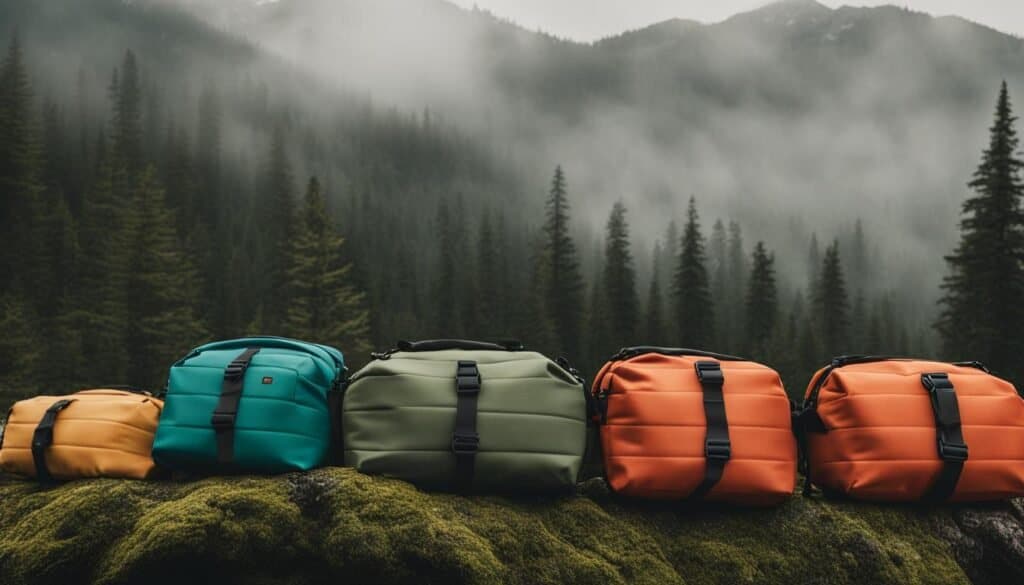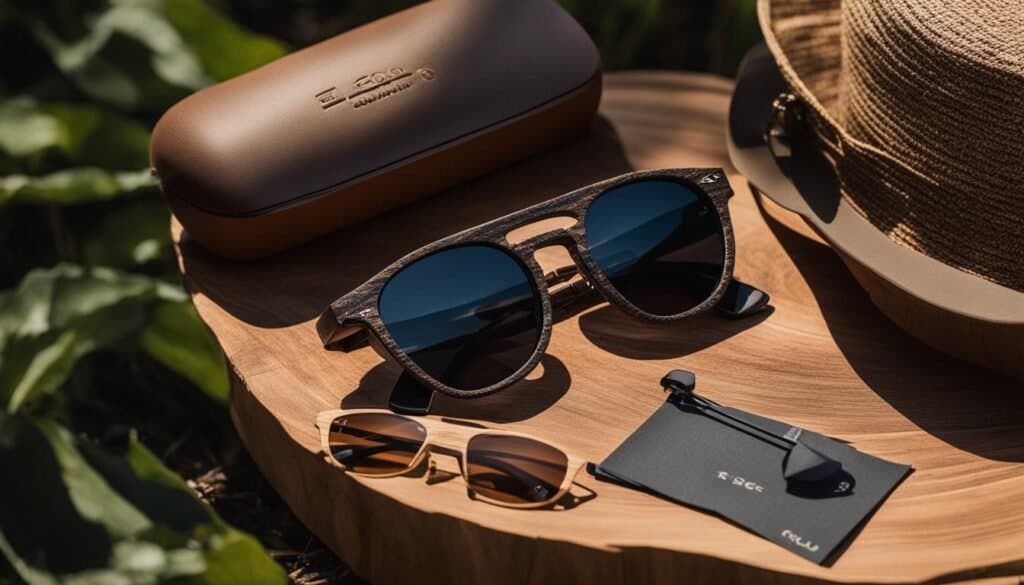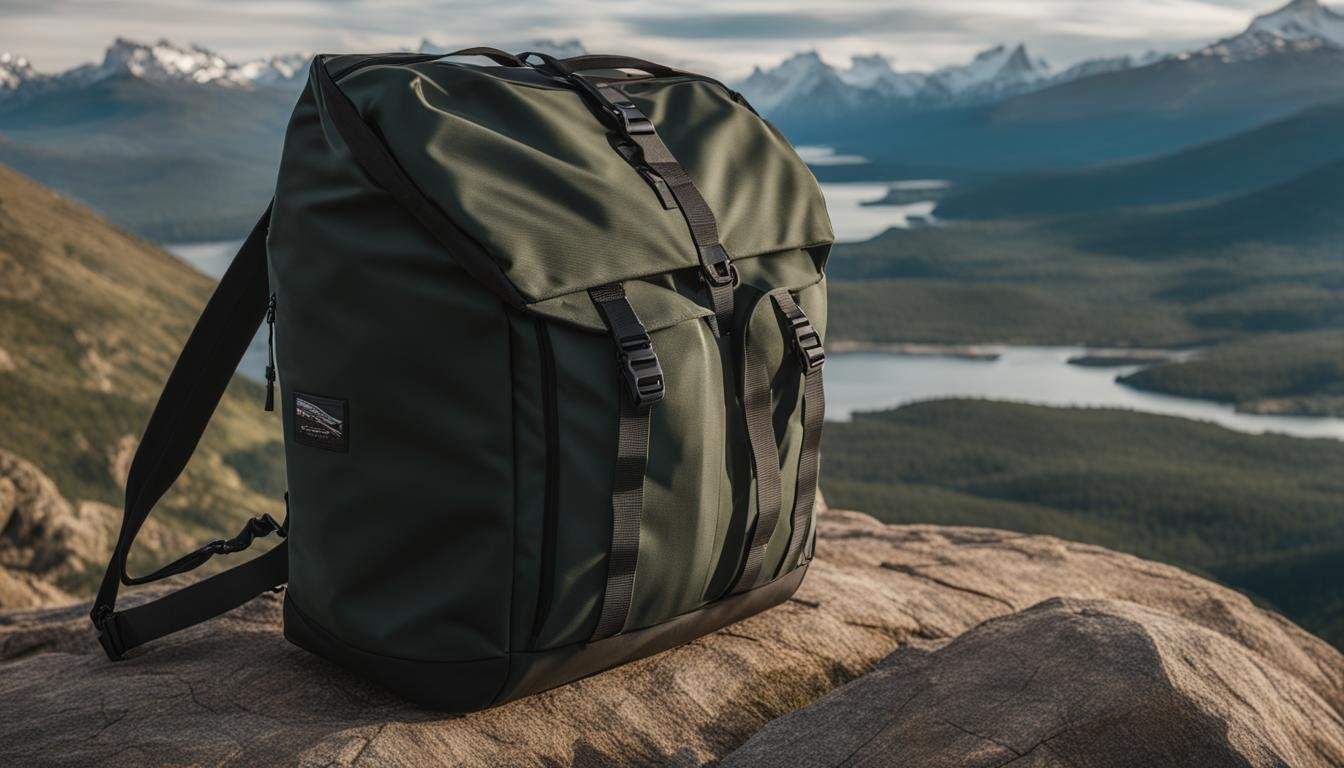As an outdoor enthusiast, I understand the importance of preserving our planet’s beautiful natural environments. That’s why it’s essential to consider the impact of our choices when it comes to Earth-friendly materials for outdoor gear. Whether we’re gearing up for eco-adventures, seeking sustainable hiking gear, or browsing for eco-friendly camping equipment, opting for environmentally friendly outdoor apparel is crucial.
Join me as we explore some of the best eco-friendly materials and brands that enable us to leave a lighter footprint while enjoying the great outdoors—because a sustainable adventure is a guilt-free adventure.
Key Takeaways
- Eco-friendly materials help reduce environmental impact and preserve natural areas
- Natural fibers like hemp, linen, and organic cotton offer durable and comfortable options for sustainable apparel
- Recycled synthetics, such as recycled polyester, are an innovative way to repurpose plastic waste into functional gear
- Biodegradable materials like mushroom leather and plant-based inks showcase the industry’s commitment to creating fully sustainable products
- Eco-conscious footwear made from cork, natural latex, and recycled rubber provide stylish, supportive, and sustainable options for outdoor enthusiasts
- Advanced eco-friendly technologies like Tencel and Modal are revolutionizing sustainable outdoor apparel
- Pioneering brands like Patagonia, Prana, and Cotopaxi lead the way in providing ethical and environmentally friendly outdoor gear options
Why Choosing Eco-Friendly Materials Matters for Outdoor Enthusiasts
As outdoor enthusiasts, we have a responsibility to protect the environment we cherish. Prioritizing eco-friendly outdoor gear allows us to enjoy our adventures while adhering to the important principles of Leave No Trace and environmental stewardship. The outdoor industry has a long history of relying on synthetic materials for durability, but times are changing, and outdoor gear sustainability is now an essential consideration for nature lovers.
“In nature, nothing exists alone.” – Rachel Carson, Silent Spring
Brands like Patagonia, Fjällräven, and Black Diamond are championing eco-friendly materials such as recycled nylon and adopting ethical practices like Fair Trade certification and supply chain transparency. By choosing these brands, we not only support environmental stewardship but also encourage other companies to follow suit.
One prime example of eco-friendly outdoor gear in action is Patagonia’s Black Hole bag series, which uses 100% bluesign® approved recycled polyester. This environmentally responsible choice minimizes the need for new materials and helps reduce waste.
Outlined below are three essential reasons why outdoor enthusiasts should prioritize eco-friendly materials:
- Reducing Waste: By choosing gear made from recycled materials, we decrease the demand for new resources and reduce landfill waste. This supports a Circular Economy, where products are kept in use and materials are repurposed.
- Offsetting Manufacturing Emissions: Eco-conscious brands often work to offset their carbon emissions by investing in projects like reforestation or renewable energy. This helps counterbalance the environmental impact of their products.
- Preserving Natural Areas and Biodiversity: Opting for eco-friendly gear contributes to the protection of our planet’s diverse ecosystems and the countless species that call them home.
As outdoor enthusiasts, we can do our part to leave a minimal footprint on the environment as we explore its wonders. By investing in eco-friendly outdoor gear, we engage in a commitment to environmental stewardship, ensuring that future generations can enjoy the same pristine landscapes that we appreciate today.
Organic and Natural Fibers: Hemp, Linen, and Organic Cotton Benefits
As more outdoor enthusiasts opt for eco-friendly hiking apparel and gear, materials like hemp, linen, and organic cotton are emerging as popular choices. These natural fibers offer a range of benefits, including durability, comfort, breathability, and reduced environmental impact.
Camping Gear Pros suggests choosing outdoor gear made from sustainable materials like organic cotton, hemp, and bamboo for clothing. Also, gear made from recycled materials like plastic bottles and fishing nets is becoming increasingly popular.
The Durability and Comfort of Hemp in Outdoor Apparel
Hemp outdoor apparel is gaining traction, thanks to the durable natural fibers found in this eco-conscious gear. As one of the strongest and most resilient plant fibers available, hemp can withstand harsh outdoor conditions and provide superior longevity, compared to synthetic materials. Furthermore, its natural anti-microbial properties help keep odors at bay, making it a practical choice for sustainable hiking adventures.
Linen: A Naturally Breathable Option for Eco-Conscious Hikers
When it comes to attire for eco-conscious hikers, breathable linen is an exceptional choice for maintaining comfort while on the trail. As a natural fiber derived from the flax plant, linen features an innate moisture-wicking ability that helps regulate body temperature, ensuring hikers remain cool and dry during even the most intense hikes.
Organic Cotton: Softness Meets Sustainability for Outdoor Gear
Outdoor enthusiasts searching for soft, sustainable clothing should look to organic cotton gear, which combines superior comfort with eco-friendly materials. Unlike conventional cotton, organic cotton is grown without the use of harmful pesticides and chemicals, making it a healthier choice for both consumers and the environment. Eco-friendly brands like Patagonia and Prana prioritize organic cotton in their outdoor apparel because of its luxurious feel and commitment to reducing environmental impact.
“Choosing organic and natural fibers for your outdoor gear is an investment in not only your comfort, but the health of our planet.”
Choosing hemp, linen, and organic cotton for your outdoor gear not only benefits your personal comfort and well-being but also supports a sustainable future for the planet. Embrace eco-friendly hiking apparel made from these natural fibers, and experience their unique benefits while contributing to a greener world.
The Rise of Recycled Synthetics: From Bottles to Backpacks
As awareness of the environmental impact of traditional outdoor gear materials has grown, the outdoor equipment industry has witnessed an impressive rise in the use of recycled synthetics. These sustainable materials, like recycled polyester, are transforming products by repurposing items such as plastic bottles into durable outdoor gear like backpacks.
One brand leading the charge in utilizing recycled synthetics is Patagonia. Through their commitment to environmental responsibility, the company is creating sustainable outdoor equipment made entirely from recycled polyester. This helps reduce the reliance on virgin plastics and supports responsible disposal methods.

I was amazed to find that my new hiking backpack from Patagonia was made entirely from recycled materials. It feels fantastic to be contributing to a more sustainable approach to outdoor gear with each purchase.
In addition to backpacks and apparel, recycled synthetics are also being utilized in various outdoor equipment, such as sleeping bags, tents, and even climbing ropes. This widespread adoption demonstrates the versatility and potential of these materials in offering sustainable alternatives to traditional synthetic gear.
Mother Earth Living recommends backpacks made of 98 percent recycled materials, mostly from recycled plastic bottles. Additionally, they highlight solar panel-embedded packs and messenger bags that can charge personal electronics.
| Outdoor Gear | Recycled Material |
|---|---|
| Backpacks | Recycled Polyester |
| Sleeping bags | Recycled Insulation |
| Tents | Recycled Fabrics |
| Climbing Ropes | Recycled Nylon |
The use of recycled synthetics aligns with the outdoor industry’s drive to develop innovative and eco-friendly alternatives. By embracing these materials, companies are making a significant stride in minimizing the environmental impact associated with the manufacturing and disposal of outdoor gear.
- Research the materials used in your outdoor equipment and opt for products made from recycled synthetics.
- Choose brands, like Patagonia, that prioritize sustainability in their manufacturing processes and product development.
- Advocate for more sustainable materials in outdoor gear within your social circles.
By choosing to support products and brands that utilize recycled synthetics, we can all play a part in minimizing our environmental impact and fostering a more sustainable future for outdoor exploration.
Biodegradable Innovations: The Emergence of Mushroom Leather and Plant-Based Inks
As the demand for eco-friendly outdoor gear continues to grow, sustainable innovations are leading the way with the development of biodegradable materials such as mushroom leather and plant-based inks. These groundbreaking alternatives represent a significant shift toward eco-conscious manufacturing processes and a reduced environmental impact.

One such innovation, mushroom leather, is crafted from mycelium, the root structure of mushrooms. Mushroom leather is a sustainable, biodegradable, and cruelty-free alternative to traditional leather and synthetics used in outdoor gear. Offering a similar strength, breathability, and durability to animal leather, mushroom leather boasts an incredible potential for revolutionizing the creation of eco-friendly outdoor apparel, accessories, and footwear.
A part of this game-changing movement, plant-based inks provide an eco-friendly alternative to petroleum-based inks commonly used in the production of outdoor gear. Traditionally, inks have been laden with harmful chemicals, which can leach into the environment during product disposal. Plant-based inks, on the other hand, significantly reduce the negative environmental impacts.
“The utilization of mushroom leather and plant-based inks ushers in a new era of biodegradable, eco-conscious materials for outdoor gear. These sustainable innovations promise to minimize waste and reduce the pressure on our natural resources while maintaining high-quality gear for outdoor enthusiasts.”
- Mushroom Leather: A durable, breathable, and biodegradable alternative to traditional leather and synthetics.
- Plant-Based Inks: A sustainable solution to petroleum-based inks, offering eco-friendly production without sacrificing performance.
| Material | Key Features | Environmental Impact |
|---|---|---|
| Mushroom Leather | Durable, breathable, cruelty-free, biodegradable | Low impact on resources, eco-friendly disposal |
| Plant-Based Inks | Non-toxic, high-quality color, biodegradable | Reduced resource demands, responsible waste management |
Through the incorporation of biodegradable materials like mushroom leather and plant-based inks, outdoor gear manufacturers can lead the industry toward a more environmentally responsible future. These sustainable innovations not only inspire conscious consumerism but also serve as powerful catalysts for change in the quest to preserve our planet for generations of outdoor enthusiasts to come.
Treading Lightly with Sustainable Footwear: Cork, Natural Latex, and Recycled Rubber
As the push for eco-friendly alternatives in outdoor gear continues to grow, sustainable footwear options are rising in popularity among conscientious consumers. In this section, we’re going to explore the supportive nature of cork hiking boots, the resilience and renewability of natural latex rubber, and the transformational impact of recycled rubber footwear on the industry.
The Supportive Nature of Cork in Eco-Friendly Hiking Boots
Traditionally, hiking boots have relied on synthetic materials for support and durability. However, cork has emerged as an environmentally friendly alternative that matches the performance of traditional materials while offering additional benefits. Cork is both lightweight and efficient at absorbing shock, providing ample support and comfort. These properties make cork hiking boots a popular choice for supportive eco-friendly footwear. Additionally, cork is derived from a renewable resource, the bark of the cork oak tree, making it an ideal material for those seeking sustainable shoe materials.
Natural Latex Rubber: Resilient and Renewable Material for Outdoor Shoes
Natural latex rubber is another promising option for sustainable footwear. Derived from the sap of rubber trees, this material offers a combination of resilience and durability, making it a sought-after choice for eco-friendly outdoor shoes. Not only is natural latex rubber biodegradable, but its renewability further solidifies its standing as a sustainable shoe material. Brands are increasingly shifting to natural latex rubber for resilient outdoor materials, believing it can revolutionize eco-conscious shoes in the outdoor footwear industry.
How Recycled Rubber is Revolutionizing Eco-Conscious Footwear
Recycling rubber waste has opened up new possibilities for sustainable footwear. Recycled rubber footwear not only repurposes waste that would otherwise end up in landfills but also reduces the consumption of raw materials. This sustainable solution creates eco-conscious, stylish shoes that cater to outdoor enthusiasts.
Brands at the forefront of this movement are revolutionizing eco-conscious shoes by crafting soles and other key components from recycled rubber. Their commitment to championing sustainable shoe materials helps pave the way for a greener, more responsible future in outdoor footwear. Together, these advances in cork, natural latex rubber, and recycled rubber demonstrate the industry’s willingness to innovate and adapt to meet the growing demand for eco-friendly alternatives.
Advancements in Sustainable Technology: Eco Fabrics like Tencel and Modal
The world of outdoor apparel is witnessing significant advancements in sustainable technology, thanks to the introduction of eco fabrics like Tencel and Modal. These revolutionary materials are redefining the landscape of environmentally friendly outdoor gear, providing the perfect blend of functionality, sustainability, and performance.
Derived from renewable wood sources, Tencel eco fabric emerges as a groundbreaking option for conscious consumers. Manufactured through a closed-loop process that recycles water and solvents, the production of Tencel fabric is notably eco-conscious. This sustainable material is not only soft and smooth but also possesses moisture-wicking properties making it a perfect choice for outdoor activities.
Modal sustainable material is another game-changer in the eco-friendly fabric realm. Produced using advanced eco-friendly technology, Modal too comes from responsibly managed beech tree forests. Thanks to its superior softness and comfort, Modal occupies an important place in sustainable activewear. In addition, it is appreciated for its high breathability and longevity.
| Eco-friendly Fabric | Source | Benefits |
|---|---|---|
| Tencel | Renewable wood sources | Soft, smooth, moisture-wicking, closed-loop production |
| Modal | Responsibly managed beech tree forests | Soft, comfortable, breathable, durable |
Choosing eco-friendly fabrics like Tencel and Modal for your outdoor gear not only promotes sustainability but also allows you to enjoy the many benefits they offer, such as comfort, breathability, and durability.
- Eco-conscious production: Tencel and Modal are manufactured through environmentally responsible processes, contributing to a greener future.
- Responsibly sourced materials: Both fabrics come from renewable wood sources, ensuring a low environmental footprint.
- Enhanced comfort and performance: The softness, smoothness, and moisture-wicking properties of these fabrics provide the utmost comfort and functionality during outdoor activities.
In summary, the rise of eco fabrics like Tencel and Modal showcases how advanced eco-friendly technology is transforming the outdoor gear space. As an outdoor enthusiast, embracing these sustainable materials is a step towards a more environmentally responsible lifestyle without compromising on performance and comfort.
Green Accessories for the Outdoors: Sustainable Sunglasses and Water Bottles
In recent years, the outdoor industry has shown its commitment to producing functional gear that minimizes its environmental impact. One way they are achieving this is through the rise of green outdoor accessories, such as sustainable sunglasses and eco-friendly water bottles. These thoughtful innovations cater to eco-conscious consumers who want to tread lightly while exploring the great outdoors.

Let’s delve into some popular green outdoor accessories that can help make your outdoor adventures more sustainable:
- Sustainable Sunglasses
Plastic waste and the pollution it causes are major environmental issues. Enter sustainable sunglasses: stylish eyewear made from eco-friendly materials like recycled plastic, bamboo, and even biodegradable materials. Brands such as Proof Eyewear and Pela Vision offer a wide range of designs that protect your eyes while reducing your environmental footprint. Not only do these sunglasses utilize eco-friendly materials, but they often come with sustainable packaging and support environmental initiatives. This way, you can shield your eyes from harmful UV rays and feel good about the accessories you choose.
- Eco-Friendly Water Bottles
One of the easiest ways to be more environmentally responsible during your outdoor adventures is to invest in a reusable, eco-friendly water bottle. Not only do they reduce plastic waste, but they also encourage hydration on the go. Some notable eco-friendly water bottle brands include Klean Kanteen, S’well, and Hydro Flask. These bottles are made from stainless steel and other sustainable materials, ensuring they are durable and long-lasting. Moreover, brands such as LARQ have taken water bottle innovation a step further by incorporating UV-C LED technology that purifies water and cleans the bottle itself, making it a perfect companion for outdoor enthusiasts.
Field Mag points out the significance of the Climate Neutral certification, which indicates that a brand measures, reduces, and offsets all the carbon generated by making and delivering their products.
As the outdoor industry continues to evolve, we can expect even more green outdoor accessories to enter the market. From stylish, eco-friendly sunglasses to reusable water bottles, these sustainable items can help you indulge in your favorite outdoor activities while minimizing your environmental impact. By choosing sustainable outdoor gear, you’ll not only be protecting the environment for future generations but ensuring your own eco-friendly adventure.
Pioneering Brands Leading the Charge in Ethical Outdoor Clothing
As the importance of sustainability becomes increasingly apparent, several ethical outdoor clothing brands have emerged as leaders in the industry, paving the way for environmentally conscious gear companies to make a difference. These pioneering organizations not only utilize sustainable materials, but also adopt responsible manufacturing practices, fair labor standards, and support various environmental initiatives. Below are some of the most notable brands in the realm of ethical outdoor clothing:
- Patagonia
- Prana
- Cotopaxi

Patagonia has long been a frontrunner in sustainable outdoor apparel, setting high standards for the industry. The company makes significant efforts to reduce their environmental footprint by incorporating recycled materials, investing in renewable energy sources, and supporting preservation initiatives. Additionally, Patagonia is also known for its Worn Wear program, which encourages repairing, reusing, and recycling gear to minimize waste.
Prana focuses on producing versatile clothing suitable for both outdoor activities and everyday wear. Their commitment to sustainability is reflected in their use of organic cotton, recycled wool and polyester, and Fair Trade-certified factories. Prana also leads the charge in supply chain transparency, working towards zero waste and a reduced carbon footprint.
Cotopaxi is an environmentally conscious gear company that both designs innovative products and champions social causes. The brand is unique in that they donate 1% of their annual revenue to organizations addressing poverty, climate change, and education. Cotopaxi’s gear is crafted from sustainable materials, including recycled fabrics and eco-friendly treatments, ensuring the durability and longevity of their products without compromising on environmental responsibility.
“In every deliberation, we must consider the impact on the seventh generation… even if it requires having skin as thick as the bark of a pine.” – The Constitution of the Iroquois Nations
These standout brands represent the growing movement towards ethical outdoor clothing, proving that sustainability and high-quality gear can go hand in hand. By supporting these companies and making mindful choices when purchasing outdoor apparel, consumers contribute to a healthier and greener planet for generations to come.
Embracing Sustainable Adventures with Eco-Friendly Outdoor Gear
In conclusion, the importance of choosing eco-friendly outdoor gear for sustainable adventures cannot be overstated. As outdoor enthusiasts, we have a responsibility to minimize our environmental impact and embrace conscious consumerism. By making thoughtful decisions about the materials and products we use on our adventures, we can ensure that our treasured natural spaces will remain pristine and protected for future generations.
Natural fibers like hemp, linen, and organic cotton, alongside recycled synthetics and cutting-edge eco-fabrics like Tencel and Modal, are all fantastic options for sustainable outdoor apparel. We can also make a difference by favoring brands like Patagonia, REI, and Cotopaxi that prioritize environmentally responsible practices. By integrating sustainable choices into our outdoor gear and equipment, we embark on adventures that align with our eco-conscious beliefs.
Finally, let us not forget the power of technological advancements that help reduce our ecological footprint, such as innovative accessories like LARQ’s self-cleaning water bottle or BioLite’s CampStove. The future of sustainable outdoor gear is bright, and as passionate adventurers, let’s forge that path together, leaving nothing but eco-friendly footprints on our treasured wild places.
FAQ on Best Earth-Friendly Materials for Outdoor Gear
Q: What are the best sustainable materials for outdoor gear?
A: The best sustainable materials for outdoor gear include recycled polyester, organic cotton, hemp, and bluesign® approved fabrics. Brands like Patagonia and Cotopaxi are known for using these eco-friendly materials in their products.
Q: What are some features of the best sustainable outdoor clothing brands?
A: The best sustainable outdoor clothing brands prioritize the use of recycled and natural materials, reduce waste in their production processes, and often support environmental and social initiatives. They also offer durable, high-quality gear and apparel for outdoor pursuits.
Q: How can I find the best ethical and sustainable outdoor clothing brand?
A: You can find the best ethical and sustainable outdoor clothing brand by looking for certifications such as Fair Trade Certified™, bluesign®, or Global Organic Textile Standard (GOTS). Research and reviews can also help identify brands committed to sustainability and ethical practices.
Q: Where can I buy outdoor gear made from sustainable materials?
A: You can buy outdoor gear made from sustainable materials at eco-friendly brands’ websites and stores, as well as from retailers specializing in sustainable and ethical outdoor clothing. Look for options that use recycled materials and sustainable fabrics for your outdoor adventures.
Q: What are some examples of sustainable outdoor clothing brands?
A: Examples of sustainable outdoor clothing brands include Patagonia, Cotopaxi, prAna, and REI Co-op. These brands are known for their commitment to sustainability, using recycled materials, and supporting environmental and social initiatives.
Q: How can I ensure the outdoor gear I buy is sustainable and ethical?
A: To ensure the outdoor gear you buy is sustainable and ethical, look for brands that prioritize the use of recycled and natural materials, promote fair labor practices, and support environmental causes. Check for certifications and transparency in their production processes.
Q: What should I consider when buying outdoor gear from a sustainable brand?
A: When buying outdoor gear from a sustainable brand, consider the materials used, the brand’s commitment to ethical practices, durability and performance of the gear, and the brand’s support for environmental and social causes. Look for gear and clothing that align with your sustainable values.
Q: Is it possible to buy second-hand outdoor gear from sustainable and ethical brands?
A: Yes, you can buy second-hand outdoor gear from sustainable and ethical brands through resale platforms, thrift stores, and gear swap events. Buying used gear contributes to reducing waste and extending the life cycle of outdoor gear.
Q: How do sustainable outdoor clothing companies contribute to environmental conservation?
A: Sustainable outdoor clothing companies contribute to environmental conservation by using recycled materials, supporting conservation efforts, reducing their carbon footprint, and promoting sustainable business practices. They often contribute to environmental causes and initiatives aimed at protecting natural habitats.
Q: What are some popular activities or outdoor pursuits best suited for sustainable outdoor gear?
A: Popular activities and outdoor pursuits best suited for sustainable outdoor gear include hiking, camping, backpacking, trail running, rock climbing, kayaking, and other nature-based adventures. Using eco-friendly gear ensures minimal impact on the environment during these activities.





Leave a Reply